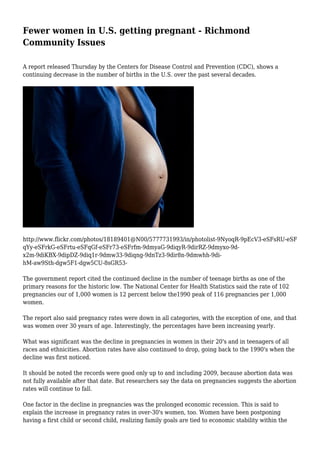
Fewer women in U.S. getting pregnant - Richmond Community Issues
- 1. Fewer women in U.S. getting pregnant - Richmond Community Issues A report released Thursday by the Centers for Disease Control and Prevention (CDC), shows a continuing decrease in the number of births in the U.S. over the past several decades. http://www.flickr.com/photos/18189401@N00/5777731993/in/photolist-9NyoqR-9pEcV3-eSFsRU-eSF qYy-eSFrkG-eSFrtu-eSFqGf-eSFr73-eSFrfm-9dmyaG-9diqyR-9dirRZ-9dmyxo-9d- x2m-9diKBX-9dipDZ-9diq1r-9dmw33-9diqng-9dnTz3-9dir8n-9dmwhh-9di- hM-aw9Sth-dgw5F1-dgw5CU-8sGR53- The government report cited the continued decline in the number of teenage births as one of the primary reasons for the historic low. The National Center for Health Statistics said the rate of 102 pregnancies our of 1,000 women is 12 percent below the1990 peak of 116 pregnancies per 1,000 women. The report also said pregnancy rates were down in all categories, with the exception of one, and that was women over 30 years of age. Interestingly, the percentages have been increasing yearly. What was significant was the decline in pregnancies in women in their 20's and in teenagers of all races and ethnicities. Abortion rates have also continued to drop, going back to the 1990's when the decline was first noticed. It should be noted the records were good only up to and including 2009, because abortion data was not fully available after that date. But researchers say the data on pregnancies suggests the abortion rates will continue to fall. One factor in the decline in pregnancies was the prolonged economic recession. This is said to explain the increase in pregnancy rates in over-30's women, too. Women have been postponing having a first child or second child, realizing family goals are tied to economic stability within the
- 2. family. The teen pregnancy rate for 2009 was 38 per 1,000 teens, down a striking 39 percent lower than the 62 per 1,000 in 1991. One of the report's authors, Sally Curtin, said the report shows a downward trend of fewer teenagers having sex, and a rise in the use of contraceptives. Andrew Cherlin, a Johns Hopkins University sociologist, said, that concerns over HIV/AIDS have probably played a role in the growing use of condoms among teenage boys. "AIDS has forced many school districts to talk about contraception, even if they didn't want to," he said.